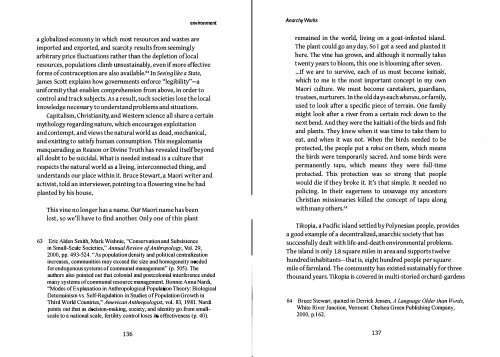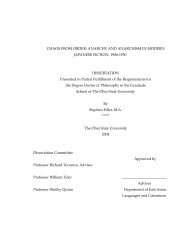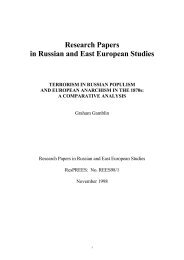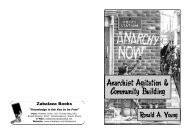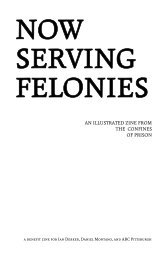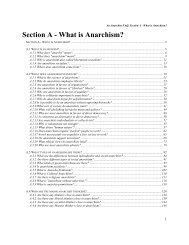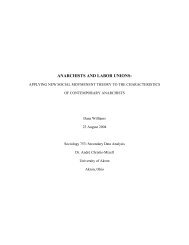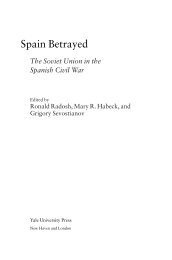Anarchy Works.pdf - Infoshop.org
Anarchy Works.pdf - Infoshop.org
Anarchy Works.pdf - Infoshop.org
Create successful ePaper yourself
Turn your PDF publications into a flip-book with our unique Google optimized e-Paper software.
environment<br />
<strong>Anarchy</strong> <strong>Works</strong><br />
a globalized economy in which most resources and wastes are<br />
imported and exported, and scarcity results from seemingly<br />
arbitrary price fluctuations rather than the depletion oflocal<br />
resources, populations climb unsustainably, even if more effective<br />
forms of contraception are also available!' In Seeing like a State,<br />
James Scott explains how governments enforce "legibility"-a<br />
uniformity that enables comprehension from above, in order to<br />
control and track subjects. As a result, such societies lose the local<br />
knowledge necessary to understand problems and situations.<br />
Capitalism, Christianity, and Western science all share a certain<br />
mythology regarding nature, which encourages exploitation<br />
and contempt, and views the natural world as dead, mechanical,<br />
and existing to satisfy human consumption. This megalomania<br />
masquerading as Reason or Divine Truth has revealed itself beyond<br />
all doubt to be suicidal. What is needed instead is a culture that<br />
respects the natural world as a living, interconnected thing, and<br />
understands our place within it. Bruce Stewart, a Maori writer and<br />
activist, told an interviewer, pointing to a flowering vine he had<br />
planted by his house,<br />
This vine no longer has a name. Our Maori name has been<br />
lost, so we'll have to find another. Only one of this plant<br />
63 Eric Alden Smith, Mark Wishnie, "Conservation and Subsistence<br />
in Small-Scale Societies," Annual Review ofAnthropology, Vol. 29,<br />
2000, pp. 493-524. "As population density and political centralization<br />
increases, communities may exceed the size and homogeneity needed<br />
for endogenous systems of communal management" (p. 505). The<br />
authors also pointed out that colonial and postcolonial interference ended<br />
many systems of communal resource management Bonnie Anna Nardi,<br />
"Modes of Explanation in Anthropological Population Theory: Biological<br />
Determinism vs. Self-Regulation in Studies of Population Growth in<br />
Third World Countries," American Anthropologist, vol. 83, 1981. Nardi<br />
points out that as decision-making, society, and identity go from smallscale<br />
to a national scale, fertility control loses its effectiveness (p. 40).<br />
remained in the world, living on a goat-infested island.<br />
The plant could go any day. So I got a seed and planted it<br />
here. The vine has grown, and although it normally takes<br />
twenty years to bloom, this one is blooming after seven .<br />
.. .If we are to survive, each of us must become kaitiaki,<br />
which to me is the most important concept in my own<br />
Maori culture. We must become caretakers, guardians,<br />
trustees, nurturers. In the old days each whanau, or family,<br />
used to look after a specific piece of terrain. One family<br />
might look after a river from a certain rock down to the<br />
next bend. And they were the kaitiaki of the birds and fish<br />
and plants. They knew when it was time to take them to<br />
eat, and when it was not. When the birds needed to be<br />
protected, the people put a rahui on them, which means<br />
the birds were temporarily sacred. And some birds were<br />
permanently tapu, which means they were full-time<br />
protected. This protection was so strong that people<br />
would die if they broke it. It's that simple. It needed no<br />
policing. In their eagerness to unsavage my ancestors<br />
Christian missionaries killed the concept of tapu along<br />
with many others.64<br />
Tikopia, a Pacific island settled by Polynesian people, provides<br />
a good example of a decentralized, anarchic society that has<br />
successfully dealt with life-and-death environmental problems.<br />
The island is only 1.8 square miles in area and supports twelve<br />
hundred inhabitants-that is, eight hundred people per square<br />
mile of farmland. The community has existed sustainably for three<br />
thousand years. Tikopia is covered in multi-storied orchard-gardens<br />
64<br />
Bruce Stewart, quoted in Derrick Jensen, A Language Older than Words,<br />
White River Junction, Vennont: Chelsea Green Publishing Company,<br />
2000, p.l62.<br />
136<br />
137


